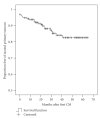Clinical characteristics of cutaneous melanoma and second primary malignancies in a dutch hospital-based cohort of cutaneous melanoma patients
- PMID: 20585479
- PMCID: PMC2879611
- DOI: 10.1155/2009/479183
Clinical characteristics of cutaneous melanoma and second primary malignancies in a dutch hospital-based cohort of cutaneous melanoma patients
Abstract
The increasing number of living cutaneous melanoma patients and the increased risk of developing a second primary tumour incited us to analyse the clinical characteristics of cutaneous melanoma and define the frequency, site, and type of second primary cancers in cutaneous melanoma patients. We collected data on patients who visited the Department of Dermatology at the Radboud University Nijmegen Medical Centre and were newly diagnosed with cutaneous melanoma or metastasis of melanoma with unknown primary localization between 2002 and 2006. A total of 194 cases were included; eleven patients developed a subsequent melanoma, 24 had at least one basal cell carcinoma, three had at least one squamous cell carcinoma, and 21 patients had a second non-cutaneous primary malignancy. In conclusion, 48 patients developed a subsequent malignancy. As nonmelanoma skin cancer is the most frequent second malignancy, our results subscribe to the necessity of follow-up by a dermatologist.
Figures



Similar articles
-
Malignant melanoma and other second cutaneous malignancies in cutaneous T-cell lymphoma. The influence of additional therapy after total skin electron beam radiation.Arch Dermatol. 1995 Apr;131(4):432-5. Arch Dermatol. 1995. PMID: 7726585 Review.
-
Risks of different skin tumour combinations after a first melanoma, squamous cell carcinoma and basal cell carcinoma in Dutch population-based cohorts: 1989-2009.J Eur Acad Dermatol Venereol. 2018 Mar;32(3):382-389. doi: 10.1111/jdv.14587. Epub 2017 Oct 17. J Eur Acad Dermatol Venereol. 2018. PMID: 28898461
-
Second malignancies in melanoma patients in Thuringia.J Eur Acad Dermatol Venereol. 2000 Nov;14(6):479-83. doi: 10.1046/j.1468-3083.2000.00162.x. J Eur Acad Dermatol Venereol. 2000. PMID: 11444270
-
Nonmelanoma skin cancers and risk of subsequent malignancies: a cancer registry-based study in Bulgaria.Neoplasma. 2002;49(2):81-5. Neoplasma. 2002. PMID: 12088110
-
The utility of positron emission tomography with and without computed tomography in patients with nonmelanoma skin cancer.J Am Acad Dermatol. 2016 Jul;75(1):186-96. doi: 10.1016/j.jaad.2016.01.045. Epub 2016 Mar 16. J Am Acad Dermatol. 2016. PMID: 26992283 Review.
Cited by
-
Epidemiological and clinical characteristics of malignant melanoma in Southeast Anatolia in Turkey.Pan Afr Med J. 2016 May 6;24:22. doi: 10.11604/pamj.2016.24.22.9254. eCollection 2016. Pan Afr Med J. 2016. PMID: 27583086 Free PMC article.
-
Similar survival of patients with multiple versus single primary melanomas based on Utah Surveillance, Epidemiology, and End Results data (1973-2011).J Am Acad Dermatol. 2018 Aug;79(2):238-244. doi: 10.1016/j.jaad.2018.02.055. Epub 2018 Mar 1. J Am Acad Dermatol. 2018. PMID: 29499295 Free PMC article.
-
Epidemiological aspects of melanoma at a university hospital dermatology center over a period of 20 years.An Bras Dermatol. 2013 May-Jun;88(3):344-53. doi: 10.1590/abd1806-4841.20131855. An Bras Dermatol. 2013. PMID: 23793193 Free PMC article.
-
Various Dermatoses What the Patients with Cutaneous Melanoma Had Anxiety for the Recurrence during Postoperative Surveillance.Ann Dermatol. 2017 Aug;29(4):433-437. doi: 10.5021/ad.2017.29.4.433. Epub 2017 Jun 21. Ann Dermatol. 2017. PMID: 28761291 Free PMC article.
References
-
- de Vries E, van de Poll-Franse LV, Louwman WJ, de Gruijl FR, Coebergh JWW. Predictions of skin cancer incidence in The Netherlands up to 2015. British Journal of Dermatology. 2005;152(3):481–488. - PubMed
-
- de Vries E, Bray FI, Coebergh JWW, Parkin DM. Changing epidemiology of malignant cutaneous melanoma in Europe 1953–1997: rising trends in incidence and mortality but recent stabilizations in western Europe and decreases in Scandinavia. International Journal of Cancer. 2003;107(1):119–126. - PubMed
-
- Jemal A, Devesa SS, Hartge P, Tucker MA. Recent trends in cutaneous melanoma incidence among whites in the United States. Journal of the National Cancer Institute. 2001;93(9):678–683. - PubMed
-
- MacKie RM, Bray CA, Hole DJ, et al. Incidence of and survival from malignant melanoma in Scotland: an epidemiological study. The Lancet. 2002;360(9333):587–591. - PubMed
-
- Marrett LD, Nguyen HL, Armstrong BK. Trends in the incidence of cutaneous malignant melanoma in New South Wales, 1983–1996. International Journal of Cancer. 2001;92(3):457–462. - PubMed
LinkOut - more resources
Full Text Sources
Research Materials

